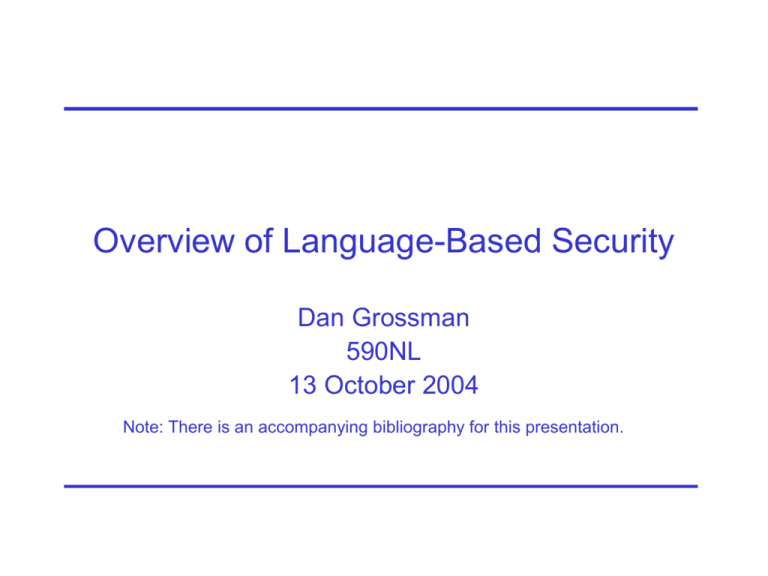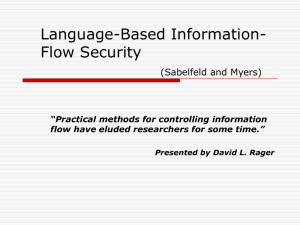ppt
advertisement

Overview of Language-Based Security
Dan Grossman
590NL
13 October 2004
Note: There is an accompanying bibliography for this presentation.
Why PL?
To the extent security is a software problem, PL has a
powerful tool set (among several)
• Much progress in last few years
• Practical applications
• Plenty of open and fun core-CS research
( But security is not just a software problem:
encryption, tamper-proof hardware, policy design,
social factors, …)
13 October 2004
Grossman: Language-Based Security
2
The plan
• 1st things 1st : the case for strong languages
• Overview of the language-based approach to security
(as opposed to software quality)
• Many examples and pointers
Next week:
UW projects and their connection to security
13 October 2004
Grossman: Language-Based Security
3
Just imagine…
• Tossing together 20000000 lines of code
• From 1000s of people at 100s of places
• And running 10000000s of computers holding data of
value to someone
• And any 1 line could have arbitrary effect
All while espousing the principle of least privilege?!
13 October 2004
Grossman: Language-Based Security
4
Least Privilege
“Give each entity the least authority necessary to
accomplish each task”
versus
• Buffer overruns (read/write any memory)
• Code injection (execute any memory)
• Coarse library access (system available by default)
Secure software in unsafe languages may be possible,
but it ain’t because of least privilege
13 October 2004
Grossman: Language-Based Security
5
The old argument
• Better languages better programs better security
– Technically: strong abstractions isolate errors
(next slide)
• “But safe languages are slow, impractical, imbractical”
–
–
–
–
So work optimized safe, high-level languages
Other work built safe C-like languages (me,…)
Other work built safe systems (SPIN,…)
(and Java started bractical and slow)
• Meanwhile, seminar on TC, not performance
13 October 2004
Grossman: Language-Based Security
6
Abstraction for Security
Memory safety isolates modules, making strong
interfaces (restricted clients) enough:
Example: Safer C-style file I/O (simplified)
struct FILE;
FILE* fopen(const char*, const char*);
int
fgetc(FILE*);
int
fputc(int, FILE*)
int
fclose(FILE*);
No NULL, no bad modes, no r/w on w/r, no use-afterclose, else “anything might happen”
13 October 2004
Grossman: Language-Based Security
7
File Example
Non-NULL (Cyclone)
struct FILE;
FILE* fopen(const char@, const char@);
int
fgetc(FILE@);
int
fputc(int, FILE@)
int
fclose(FILE@);
Client must check fopen result before use
More efficient than library-side checking
13 October 2004
Grossman: Language-Based Security
8
File Example
No bad modes (library design)
struct FILE;
FILE* fopen_r(const char@);
FILE* fopen_w(const char@);
int
fgetc(FILE@);
int
fputc(int, FILE@)
int
fclose(FILE@);
13 October 2004
Grossman: Language-Based Security
9
File Example
No reading files opened for writing and vice-versa
Repetitive version:
struct FILE_R;
struct FILE_W;
FILE_R* fopen_r(const char@);
FILE_W* fopen_w(const char@);
int
fgetc(FILE_R@);
int
fputc(int, FILE_W@)
int
fclose_r(FILE_R@);
int
fclose_w(FILE_W@);
13 October 2004
Grossman: Language-Based Security
10
File Example
No reading files opened for writing and vice-versa
Phantom-type version (PL folklore):
struct FILE<‘T>;
struct R; struct W;
FILE<R>* fopen_r(const char@);
FILE<W>* fopen_w(const char@);
int
fgetc(FILE<R>@);
int
fputc(int, FILE<W>@)
int
fclose(FILE<‘T>@);
13 October 2004
Grossman: Language-Based Security
11
File Example
No using files after they’re closed
Unique pointers (Vault, ArchJava, Cyclone 0.8)
struct FILE<‘T>;
struct R; struct W;
unique FILE<R>* fopen_r(const char@);
unique FILE<W>* fopen_w(const char@);
int fgetc(FILE<R>@);
int fputc(int, FILE<W>@)
int fclose(unique use FILE<‘T>@);
13 October 2004
Grossman: Language-Based Security
12
Moral
• Language for stricter interfaces:
– Pushes checks to compile-time / clients
(faster and earlier defect detection)
– Can specify sophisticated idioms
– Incremental adoption possible
• Memory safety a precondition to any guarantee
• But getting security right this way is still hard, and
hard to verify
– “Does this huge app send data from home
directories over the network?”
13 October 2004
Grossman: Language-Based Security
13
The plan
• 1st things 1st : the case for good languages
– Some more on Cyclone next week (array lengths)
• Overview of the language-based approach to security
(as opposed to software quality)
• Many examples and pointers
Language-based security is more than good code:
Using PL techniques to enforce a security policy
13 October 2004
Grossman: Language-Based Security
14
Summary of dimensions
1.
2.
3.
4.
5.
How is a policy expressed?
What policies are expressible?
What is guaranteed?
What is trusted (the TCB) ?
How is the policy enforced?
Grain of salt: This list is in alpha-test.
But it should help us talk about lots of good work.
13 October 2004
Grossman: Language-Based Security
15
Dimensions of L.B. Security
1. How is a policy expressed?
code:
void safesend(){if(disk_read) die();…}
automata:
read
send
read
logic:
send
S
X
states s. read(s) (forever(not(send)))(s)
informally: “no send after read”
implicitly: % CommunicationGuard –f foo.c
13 October 2004
Grossman: Language-Based Security
16
Dimensions of L.B. Security
2. What policies are expressible?
safety properties: “bad thing never happens”
send-after-read, lock reacquire, exceed resource limit
liveness properties: “good thing eventually happens”
lock released, starvation-freedom, termination
– often over-approximated with safety property
information flow
(cf. mandatory/discretionary access control)
confidentiality vs. integrity
(cf. read/write)
13 October 2004
Grossman: Language-Based Security
17
Dimensions of L.B. Security
3. What is guaranteed?
Enforcement:
sound: no policy-violation occurs
complete: no policy-follower is accused
both
neither
Execution:
meaning preserving: programs unchanged
“IRM” guarantee: policy-followers unchanged
13 October 2004
Grossman: Language-Based Security
18
Dimensions of L.B. Security
4. What is trusted (the TCB) ?
Hardware, network, operating system, type-checker,
code-generator, proof-checker, web browser, …
programmers, sys admins, end-users, …
crypto, logic, …
(less is good)
13 October 2004
Grossman: Language-Based Security
19
Dimensions of L.B. Security
5. How is the policy enforced?
static analysis: before program runs
often more conservative, efficient
“in theory, more powerful than dynamic analysis”
dynamic/post-mortem analysis: while/after program runs
“in theory, more powerful than static analysis”
code generation: how code is compiled
environment: libraries, hardware
13 October 2004
Grossman: Language-Based Security
20
Summary of dimensions
1.
2.
3.
4.
5.
How is a policy expressed?
What policies are expressible?
What is guaranteed?
What is trusted (the TCB) ?
How is the policy enforced?
Grain of salt: This list is in alpha-test.
13 October 2004
Grossman: Language-Based Security
21
The plan
• 1st things 1st : the case for good languages
• Overview of the language-based approach to security
(as opposed to software quality)
• Many examples and pointers
See accompanying bibliography for proper attribution
13 October 2004
Grossman: Language-Based Security
22
Proof-Carrying Code
• Motivation: Smaller TCB, especially network
• How expressed: logic
• How enforced: proof-checker
Source
compiler
VCGen
Native
code
Annota
tions
VCGen
VC
VC
Picture
adapted from
Peter Lee
13 October 2004
Proof
generator
Code producer
Proof
checker
Proof
Code consumer
Grossman: Language-Based Security
23
PCC in hindsight (personal view)
• “if you can prove it, you can do it”
– dodges undecidability
• key contributions:
– proof-checking easier than proof-finding
– security without authentication
• works well for many compiler optimizations
• but in practice, policies weak & over-approximated
– e.g., is it exactly the Java metadata for a class
– e.g., does it use standard calling convention
13 October 2004
Grossman: Language-Based Security
24
Other PCC instances
• Typed Assembly Language (TAL)
– As in file-example, types let you encode many
policies (in theory, any safety property!)
– Proof-checker now type-checker, vcgen more
implicit
– In practice, more flexible data-rep and callingconvention, worse arithmetic and flow-sensitivity
• Foundational PCC (FPCC)
– Don’t trust vcgen, only semantics of machine and
security policy encoded in logic
– Impressive TCB, > 20 grad-student years
13 October 2004
Grossman: Language-Based Security
25
Verified compilers?
• A verified compiler is a decades-old dream
– I don’t think we’re close
– Tony Hoare’s recent “grand challenge”
• Why is PCC-style easier?
– Judges compiler on one program at a time
– Judges compiler on a security policy, not
correctness
• This is little consolation to programmers hitting
compiler bugs
• Next week: UW work on optimizations that are
provably correct for all source programs
13 October 2004
Grossman: Language-Based Security
26
Inline-Reference Monitors
• Rules of the game:
– Executing P goes through states s1, s2, …
– A safety policy S is a set of “bad states” (easily
summarized with an automata)
– For all P, the IRM must produce a P’ that:
• obeys S
• if P obeys S, then P’ is equivalent to P
• Amazing: An IRM can be sound and complete for any
(non-trivial) safety property S
– Proof: Before going from s to s’, halt iff s’ is bad
– For many S, there are more efficient IRMs
13 October 2004
Grossman: Language-Based Security
27
(Revisionist) Example
• In 1993, SFI:
– Without hardware support, ensure code accesses
only addresses in some aligned 2n range
– IRM: change every load/store to mask the address
sto r1->r2
and 0x000FFFFF,r2->r3
or 0x2a300000,r3->r3
sto r1->r3
– Sound (with reserved registers and special care to
restrict jump targets)
– Complete (if original program obeyed the policy,
every mask is a no-op)
13 October 2004
Grossman: Language-Based Security
28
Dodging undecidability
How can an IRM enforce safety policies soundly and
completely:
• It rewrites P to P’ such that:
– P’ obeys S
– If P obeys S, then P’ is equivalent to P
• It does not decide if P satisfies the policy
13 October 2004
Grossman: Language-Based Security
29
Static analysis for information flow
Information-flow properties include:
• Confidentiality (secrets kept)
• Integrity (data not corrupted)
(too strong but useful) confidentiality: non-interference
• “High-security input never affects low-security output”
H
P
L
H’
L’
H1,H2,L
if P(H1,L) = (H1’,L’)
then H2’
P(H2,L) = (H2’,L’)
(Generalizes to arbitrary lattice of security levels)
13 October 2004
Grossman: Language-Based Security
30
Non-interference
• Non-interference is about P, not an execution of P
– not a safety (liveness) property; can’t be monitored
• Robust definition depending on “low outputs”
– I/O, memory, termination, timing, TLB, …
– Extends to probabilistic view (cf. DB full disclosure)
• Enforceable via sound (incomplete) dataflow analysis
– L ≤ H, assign each variable a level sec(x)
e1 + e2
max(sec(e1),
sec(e2))
13 October 2004
x := e
sec(e) if
sec(e)≤ sec(x)
Grossman: Language-Based Security
if(x) e;
sec(x) if
sec(x)≤sec(e)
31
Information-flow continued
e1 + e2
max(sec(e1),
sec(e2))
x := e
sec(e) if
sec(e)≤sec(x)
if(x) e;
sec(x) if
sec(x)≤sec(e)
• Implicit flow prevented, e.g., if(h) l:=3
• Conservative, e.g.,
l:=h*0; if(h) l:=3 else l:=3
• Integrity: exact same rules, except H ≤ L !
• One way to “relax noninterference with care” (e.g., JIF)
– declassify(e) : L e.g., average
– endorse(e) : H e.g., confirmed by > k sources
13 October 2004
Grossman: Language-Based Security
32
Software model checking
Predicate-refinement approach (SLAM, Blast)
abstraction
program +
safety prop
Refinement
predicates
feasibility
checker
concrete
counterexample path
13 October 2004
finite-state program
violation finder
(mc)
abstract
counterexample path
Picture adapted from Tom Ball
Grossman: Language-Based Security
33
Software model checking
• Sound, complete, and static?!
– (That picture has a loop)
– In practice, the static pointer analysis gives out
first with a “don’t know”
– For model-checking C, typically make weak-butunsound memory-safety assumptions
• Predicate-refinement just one approach (see
bibliography for others)
13 October 2004
Grossman: Language-Based Security
34
Metacompilation
Write application-specific checkers in terms of code
patterns and automata
+ Define checkers without being a compiler writer
− Unsound (aliasing, memory safety, …)
− Syntactic patterns ensure incompleteness w.r.t. the
semantic policy you care about
+ Well-designed to reduce false positives and rank
potential violations
+ Bugs get found and fixed (1000s in Linux)
Well-designed extensible bug-finders are great,
but they never ensure a policy is obeyed
13 October 2004
Grossman: Language-Based Security
35
So far: more general approaches
•
•
•
•
•
PCC
IRM
Information Flow
(Refinement-Based) Model Checking
Extensible Bug-Finding
Many other tools/techniques have narrower goals
and are correspondingly easier to use…
lint-like tools, confinement, stack inspection,
type qualifiers, …
13 October 2004
Grossman: Language-Based Security
36
Push-button bug-finding
• Prefix, Splint (LCLint), MS Office annotations, etc.
• Does nothing for malice
• Extensibility less important than turning off features,
minimizing false positives (ideally complete), and
prioritizing results
– Typically based on “smelly syntactic patterns”
• Dynamic counterparts: Purify, etc.
13 October 2004
Grossman: Language-Based Security
37
Confinement
Stronger than private fields, weaker than confidential
• Captures a useful idiom (copy to improve integrity)
• Shows private describes a field, not a value
• Backwards-compatible, easy to use
confined class
private Identity[]
ConfIdent{ … }
signers;
…
ConfIdent[] signers;
public Identity[]
…
getSigners() {
public Identity[]
//breach: should copy
getSigners() {
return signers;
// must copy
}
}
13 October 2004
Grossman: Language-Based Security
38
Java Stack Inspection
• Methods have principals (e.g., code source)
• Principals have privileges (e.g., file-delete)
• Operations:
– BeginPrivilege(); // use “my” privileges
(set a bit in the call frame)
– CheckPrivilege(P); // check for privilege P
(start at current stack pointer, find first frame with
bit set; check the frame’s method’s principal’s
privileges)
+ principle of least privilege (default is less enabled)
− unclear what the policy is
13 October 2004
Grossman: Language-Based Security
39
Stack Inspection Examples
delete_file(String s){
CheckPrivilege(file_delete);
…
}
util(Object evil) {
… do not call BeginPrivilege() …
evil.m(); // safe, unknown callback
}
delete_tmp_a() {
BeginPrivilege();
delete_file(“/tmp/a”);
}
13 October 2004
Grossman: Language-Based Security
40
Type Qualifiers
• Programmer defines qualifiers…
– e.g., locked/unlocked
• and how “key functions” affect them
– e.g., locked mtx acquire(unlocked mtx);
• A scalable flow-sensitive analysis ensures the
qualifiers are obeyed
– e.g., acquire never passed a locked mtx
• Precision typically limited by aliasing
• Other published uses:
– const-inference, tainted-strings, …
13 October 2004
Grossman: Language-Based Security
41
Take-Away Messages
• PL has great tools for software security; good
languages are just a start
• Many approaches to what to enforce and how
• A hot area, with aesthetically pleasing results and
practical applications
• As always, learning related work is crucial
• This was 100 hours of material in 45(?!) minutes:
– see the bibliography and come talk to me
13 October 2004
Grossman: Language-Based Security
42





